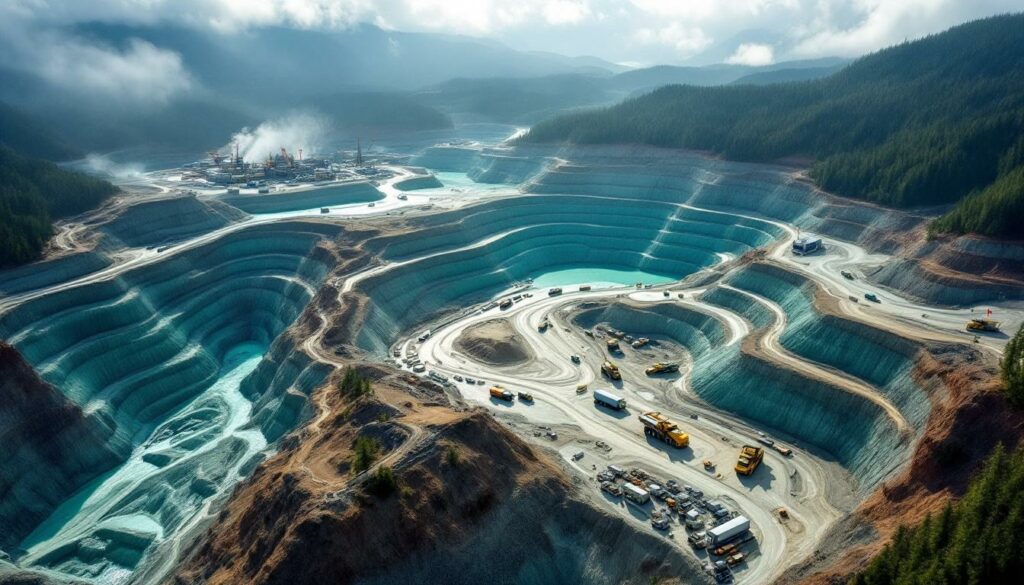Highland Valley Copper Mine Extension Receives Environmental Approval
Teck Resources has secured a crucial environmental approval from the British Columbia government for its Highland Valley Copper Mine extension project. This significant milestone allows Canada's largest copper operation to extend its operational life into the mid-2040s, strengthening North America's critical minerals supply chain during a period of increasing global demand for copper-uranium investment insights.
Project Significance and Timeline
The environmental assessment certificate, issued on June 18, 2025, marks a critical advancement for Teck Resources' expansion plans. This approval enables the company to begin site preparation work immediately while continuing to pursue additional permits required before full construction can commence.
"This positive decision represents an important milestone for Highland Valley Copper and strengthens North America's critical minerals supply chain," said Jonathan Price, President and CEO of Teck Resources, acknowledging the collaborative effort that led to this approval.
The final construction decision from Teck's board is anticipated in the third quarter of 2025, which will determine the exact timeline for full-scale development. Highland Valley Copper, with its history of reliable production, produced approximately 158,800 tonnes of copper in 2023, making it a cornerstone of Canada's copper industry.
Economic Benefits of the Highland Valley Extension
The extension of Highland Valley Copper represents a substantial economic opportunity not only for British Columbia but for Canada's entire critical minerals sector. As copper demand continues to grow—projected at approximately 2.5% annually according to World Bank forecasts—this project positions Canada to capitalize on the global transition to renewable energy and electrification in mining.
Job Creation and Economic Impact
The extension project promises significant employment and economic benefits:
- Approximately 2,900 jobs during the construction phase
- Sustainment of roughly 1,500 direct jobs throughout the extended operational period
- An estimated annual contribution of C$500 million to Canada's gross domestic product
- Creation of additional indirect employment through supply chain activities and community services
The economic ripple effect extends beyond direct employment. According to mining industry multipliers from Statistics Canada, each direct mining job typically generates 2.5-4 additional jobs in supporting industries, suggesting the total employment impact could exceed 5,000 jobs nationally.
Strategic Importance for Copper Supply
Highland Valley's significance transcends local economic benefits. As Canada's largest copper producer, the mine plays a critical role in North America's mineral security strategy.
"Copper is essential to our clean energy future," notes Canada's Critical Minerals Strategy document from Natural Resources Canada. "A typical electric vehicle requires 2.5 times more copper than an internal combustion engine vehicle, while renewable energy systems need up to 12 times more copper than traditional power systems."
By extending Highland Valley's operational life, Teck is helping to secure a stable domestic supply of this critical mineral at a time when geopolitical tensions and supply chain vulnerabilities have highlighted the importance of reliable copper sources from stable jurisdictions.
Environmental Approval Process and Stakeholder Engagement
Securing environmental approval for a major mining project requires navigating complex regulatory frameworks and balancing diverse stakeholder interests. The process for Highland Valley's extension demonstrates the comprehensive nature of British Columbia's environmental assessment system.
Stakeholder Engagement Process
The environmental assessment involved extensive consultation with multiple parties:
- Indigenous governments with traditional territories in the project area
- Local communities and municipal authorities
- Environmental organizations and conservation groups
- Provincial and federal regulatory bodies
Jonathan Price specifically acknowledged "the thoughtful assessment and ongoing feedback from Indigenous governments, local communities, stakeholders, and regulatory authorities throughout the review process."
The engagement process likely included traditional knowledge studies, community impact assessments, and the development of mitigation measures addressing stakeholder concerns—standard practices in modern mine planning in British Columbia.
Environmental Considerations and Safeguards
While specific environmental mitigation measures weren't detailed in the announcement, the project would have been required to address:
"Mining projects in British Columbia must meet some of the world's most stringent environmental standards, including requirements for water management, tailings facility design, reclamation bonding, and closure planning," according to the BC Mining Code.
Modern copper mining operations typically implement advanced technologies for water conservation, energy efficiency, and reduced environmental footprints. Teck Resources has committed to achieving net-zero emissions by 2050, suggesting the Highland Valley extension will incorporate state-of-the-art environmental technologies to minimize ecological impacts while maximizing resource recovery.
The company likely secured approval by demonstrating progressive reclamation plans, robust water management systems, and comprehensive monitoring programs—all required components of BC's environmental assessment process.
Highland Valley's Significance to Canada's Mining Sector
Highland Valley Copper holds a distinguished position in Canada's mining landscape for several key reasons, extending beyond its production volumes to its role in Canada's industrial strategy.
Scale and Production Capacity
As Canada's largest copper mine, Highland Valley represents approximately 3% of global copper supply according to Natural Resources Canada data. The operation's scale enables economies that support competitive production costs despite being in a high-wage jurisdiction.
The mine's continued viability through the mid-2040s ensures Canada maintains its position as a significant copper producer. This is particularly important as global copper demand is projected to increase substantially—the International Energy Agency estimates that achieving net-zero emissions globally will require tripling copper production by 2050.
Critical Minerals Strategy Alignment
The Highland Valley extension perfectly aligns with Canada's Critical Minerals Strategy, which identifies copper as one of 31 minerals essential to the nation's economic security and required for the transition to a low-carbon economy.
The strategy document emphasizes that "Canada's critical minerals represent a generational opportunity" and specifically notes that "copper is vital for clean energy technologies, including wind turbines, solar panels, and electric vehicles."
With approximately 70% of global copper used in electrical applications according to the International Copper Association, Highland Valley's extension positions Canada to capitalize on growing demand for sustainably-sourced minerals from stable democratic nations.
Potential Challenges for the Highland Valley Extension
Despite securing environmental approval, the Highland Valley extension project still faces several challenges that could impact its implementation timeline and ultimate success.
Remaining Regulatory Hurdles
The environmental assessment certificate, while significant, represents only one step in a complex regulatory process. Teck Resources must still obtain numerous additional permits before construction can begin in earnest, including:
- Water licenses for increased usage or modifications
- Waste discharge permits
- Land use authorizations
- Possibly amendments to existing mining permits
The permitting timeline can be unpredictable. For comparison, Pretium Resources' Brucejack Mine in British Columbia required approximately three years to complete the permitting process after receiving its environmental assessment certificate, according to provincial records.
Market Considerations and Copper Price Volatility
The financial viability of the Highland Valley extension remains subject to copper market dynamics. Copper prices have demonstrated significant volatility, fluctuating from approximately $7,800 per tonne in 2023 to $9,200 per tonne by mid-2025, according to London Metal Exchange data.
While long-term copper price predictions remain robust due to electrification trends, short-term price fluctuations could impact project economics. Mining companies typically manage this risk through hedging strategies—Teck's 2024 financial reports indicate the company had forward contracts in place for approximately 30% of its copper output to mitigate price volatility.
Technical and Operational Considerations
As mines extend their operational lives, they often encounter technical challenges:
- Decreasing ore grades requiring more material to be processed for the same metal output
- Deeper mining operations increasing haulage costs and energy requirements
- Aging infrastructure requiring significant capital investment
The Highland Valley extension likely addresses these challenges through modernization initiatives, though specific technical approaches weren't detailed in the announcement.
Strategic Implications for Teck Resources' Future
The Highland Valley extension represents a significant component of Teck Resources' long-term strategy, particularly following the company's strategic repositioning in recent years.
Strategic Portfolio Focus
The Highland Valley extension reinforces Teck's commitment to its copper assets following the company's strategic shift away from coal. In 2023, Teck divested its steelmaking coal business to focus on critical minerals, particularly copper.
This strategic pivot aligns with global trends toward electrification and decarbonization. As noted by BMO Capital Markets analysts in 2024, "Teck's copper output could potentially double by 2030" through expansions and new projects, positioning the company as a leading copper producer.
The Highland Valley extension complements Teck's other significant copper investments, including the Quebrada Blanca Phase 2 project in Chile, which has expansion potential to reach 500,000 tonnes per annum of copper production.
Investment Implications and Financial Outlook
The project's advancement signals Teck's confidence in copper's long-term market fundamentals. The company's willingness to invest substantially in extending Highland Valley's life demonstrates its belief in the operation's continued profitability through the mid-2040s.
For investors, the Highland Valley extension offers several positive signals:
- Long-term, stable production from a proven operation in a low-risk jurisdiction
- Alignment with global decarbonization trends driving copper demand
- Lower development risk compared to greenfield projects
- Potential for enhanced returns through operational synergies and existing infrastructure
The extension also aligns with Teck's sustainability commitments, including its 2050 net-zero emissions target outlined in the company's sustainability reporting.
Highland Valley Extension: Environmental and Technological Innovations
Modern mine extensions typically incorporate significant technological and environmental advances compared to their original designs. While specific details of Highland Valley's planned upgrades weren't included in the announcement, several innovations are likely being incorporated.
Water Management and Conservation
Copper mining operations require substantial water resources for ore processing. Modern extensions typically implement:
- Closed-loop water recycling systems
- Real-time monitoring technologies for water quality
- Reduced freshwater consumption through efficiency measures
- Advanced tailings management to minimize environmental impacts
As water concerns become increasingly important in mining jurisdictions, these innovations represent not just environmental benefits but essential operational requirements.
Energy Efficiency and Emissions Reduction
With mining companies under increasing pressure to reduce carbon footprints, the Highland Valley extension likely includes:
- Electrification of mining fleets
- Renewable energy integration
- Energy recovery systems
- Automated processes to optimize resource efficiency
These investments align with Teck's publicly stated commitment to reduce carbon intensity by 33% by 2030 and achieve net-zero emissions by 2050.
Future of Copper Mining in Canada
The Highland Valley extension represents more than just a single project—it signals confidence in Canada's long-term position in the global copper industry.
Policy Environment and Investment Climate
Canada's federal and provincial governments have increasingly recognized the strategic importance of critical minerals, including copper. The approval of Highland Valley's extension suggests a supportive regulatory environment for responsible resource development that meets environmental standards.
This policy support, combined with Canada's stable political system and established mining expertise, positions the country favorably compared to some competing copper jurisdictions facing political instability or resource nationalism concerns.
Technology Integration and Sustainability
The future of Canadian copper mining, exemplified by projects like the Highland Valley extension, will likely be characterized by:
- Increasing automation and digital technologies
- Lower environmental footprints through innovative processes
- Community partnerships that deliver shared benefits
- Integration with downstream processing to capture additional value
These advancements represent an evolution of the industry toward models that balance economic returns with environmental and social responsibilities, reflecting broader mining innovation trends.
Disclaimer: This article contains forward-looking statements regarding copper markets, project timelines, and economic impacts. These projections involve known and unknown risks and uncertainties that may cause actual results to differ materially from those anticipated. Readers should not place undue reliance on these forward-looking statements, which speak only as of the date of publication.
Want to Identify the Next Major Mineral Discovery?
Stay ahead of the market with Discovery Alert's proprietary Discovery IQ model, which provides instant notifications about significant ASX mineral discoveries like those that have driven exceptional returns for companies such as De Grey Mining. Visit our discoveries page to understand how identifying major mineral announcements early can transform your investment portfolio.




